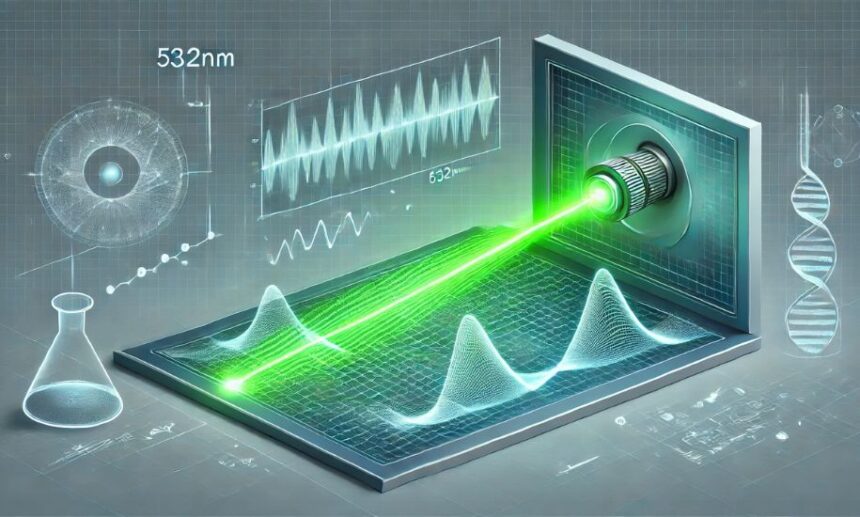Welcome to Physics Heaven, where we explore the fascinating aspects of physics and dive deep into the questions that spark curiosity. In today’s discussion, we unravel the mystery behind the question, “What is the frequency of electromagnetic radiation with wavelength 532nm?”
Understanding Electromagnetic Radiation
Electromagnetic radiation is a fundamental concept in physics. It encompasses a broad spectrum of waves, ranging from radio waves to gamma rays. These waves differ in their wavelength (λ) and frequency (ν), which are inversely related to each other.
Light with a wavelength of 532nm falls within the visible spectrum, specifically in the green region. It’s widely used in lasers, optical experiments, and scientific instruments, making it a frequent topic of interest for both professionals and enthusiasts in the field.
The Relationship Between Wavelength and Frequency
To determine what is the frequency of electromagnetic radiation with wavelength 532nm, it is essential to understand the formula that relates wavelength and frequency:
Where:
- = Frequency (in Hertz, Hz)
- = Speed of light in a vacuum (≈ 3.00 × 10⁸ m/s)
- = Wavelength (in meters, m)
The formula indicates that the frequency is inversely proportional to the wavelength. Thus, as the wavelength decreases, the frequency increases, and vice versa.
Calculating the Frequency of Electromagnetic Radiation with Wavelength 532nm
To calculate what is the frequency of electromagnetic radiation with wavelength 532nm, we first convert the wavelength from nanometers to meters:
Substituting the values into the formula:
Thus, the frequency of electromagnetic radiation with a wavelength of 532nm is approximately 5.64 × 10ⁱ⁴ Hz.
The Significance of 532nm Wavelength
Applications in Science and Technology
The wavelength of 532nm is commonly associated with green lasers. These lasers are widely used in fields like:
- Optics and Photonics: Experiments requiring high-precision wavelength control.
- Astronomy: For guiding telescopes and eliminating atmospheric distortions.
- Medicine: In procedures like laser surgery and skin treatments.
- Entertainment: Laser light shows due to the bright, visible nature of green light.
Connection to the Visible Spectrum
The 532nm wavelength is situated in the green region of the visible spectrum, which spans approximately 400nm to 700nm. Green light is particularly sensitive to the human eye, making it ideal for applications where visibility and precision are critical.
Exploring the Physics Behind the Calculation
The equation not only helps us find what is the frequency of electromagnetic radiation with wavelength 532nm, but also reveals fundamental principles of wave mechanics:
- Invariance of the Speed of Light: The speed of light in a vacuum () is a constant, underlining the consistency of electromagnetic wave propagation.
- Wave-Particle Duality: While we calculate wavelength and frequency classically, light also exhibits particle-like behavior, further explored in quantum mechanics.
- Energy and Frequency: The energy () of electromagnetic radiation is directly proportional to its frequency:
Where is Planck’s constant (≈ 6.626 × 10⁻³⁴ J⋅s). For 532nm radiation, the higher frequency translates to higher photon energy compared to longer wavelengths like red light.
Real-World Implications of 532nm Frequency
Understanding what is the frequency of electromagnetic radiation with wavelength 532nm is not merely an academic exercise. It has practical implications in:
- Environmental Monitoring: Green laser beams are used for atmospheric and pollution analysis.
- Communications: Optical communications often utilize specific wavelengths, including 532nm, for efficient signal transmission.
- Security: Devices employing this wavelength ensure precision in sensitive applications like scanning and detection systems.
Conclusion
At Physics Heaven, we believe in illuminating the beauty of physics through clarity and precision. By exploring what is the frequency of electromagnetic radiation with wavelength 532nm, we uncover the profound interplay between wavelength, frequency, and their real-world applications. The calculated frequency of 5.64 × 10ⁱ⁴ Hz reflects the harmony of nature’s laws and their influence on modern technology.
The next time you encounter a green laser or ponder over light’s properties, remember the elegance of physics that governs it. Stay curious and keep exploring the wonders of the universe with us at Physics Heaven.








